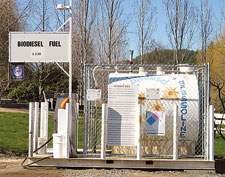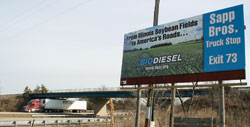 |
| Pumped Up. Biodiesel is gaining ground. |
The use of biodiesel has grown considerably in the last year, but the green fuel source probably will not replace petroleum diesel any time soon.
Consumers bought 75 million gallons of biodiesel in 2005, an increase of 300% over the previous year. Fifty-three plants currently produce the fuel and 38 new plants are expected to open within the year. Until recently, the cost was almost $1 more per gallon than petrodiesel. But thanks to government subsidies, tax credits and other incentives, the price of biodiesel today is about the same.
 Click here to view map
Click here to view map
Leland Tong, an analyst who tracks the biodiesel market, admits that the production capacity of biodiesel could never meet the current demand for diesel fuel—37 billion gal a year. According to multiple studies, the U.S. does not have enough arable farm land to do so. But Tong notes that biodiesel is “a good complement” to petroleum.
|
Produced from soybean oil, waste vegetable oil and other biolipids such as animal fat, pure biodiesel, called “B100,” can be used in any diesel engine. But it is more commonly used in lower concentrations blended with regular diesel fuel.
Biodiesel acts as a solvent that cleans engines, and it often clogs filters. It eats rubber gaskets and hoses in vehicles built before 1992. On newer diesel vehicles, “I have had a wonderful experience,” says Todd Lukes, a California-based mechanical engineer. He drives a 2005 Chevy truck and has seen positive results with biodiesel in his fuel tank. “It keeps the fuel lines clean and the filter stays incredibly clean, reducing the need for replacement,” he says.
The environmental benefits of biodiesel typically outweigh petrodiesel, as biodiesel reduces carbon monoxide emissions by 50% and carbon dioxide by 78%. It contains fewer aromatic hydrocarbons, and it can reduce particulates by 65%. Biodiesel’s downfall, however, is that it produces up to 15% more nitrogen oxides.
In areas that mandate ultra-low sulfur diesel, which has a lower viscosity and lubricity, biodiesel is a popular additive. But despite strong enthusiasm from the public, implementing biodiesel into current fleets has been problematic. Maintenance issues, quality standards and higher costs have plagued biodiesel in its infant stages of commercial use. “We are cautiously optimistic that biodiesel will have a role to play in the die-sel fuel supply,” says Rick Moskowitz, assistant general counsel for the American Trucking Association.
 |
| Growing Rapidly. Biodiesel production plants are popping up across the U.S. |
Such groups support the adoption of biodiesel but want it regulated at the federal level to avoid higher distribution and refinery costs. Much skepticism stems from recent events in Minnesota, the first state to mandate its use.
Ethanol boomed in Minnesota after the state required it in 10% of its gas supply. Mandating biodiesel was the next step to address rising petroleum costs, pollution and economic development. Lawmakers in 2002 required the use of “B2” in all diesel fuel by July 2005. B2 is a blend of 2% biodiesel and 98% conventional diesel.
The move was motivated “out of a concern that Minnesota didn't have any coal, gas or oil reserves,” says Ralph Groschem, a marketing official with the Minnesota Dept. of Agriculture. But the transition was anything but smooth. Clogged filters and a faulty flash-point standard caused the mandate to be suspended twice. Biodiesel users also noticed a reduced power output, with longer run times uphill.
Equipment fleet owners all over the state have complained about biodiesel's maintenance effects, yet producers and advocates remain optimistic. They argue that biodiesel fuel will gain ground in the new energy market. Chad Miller, an operations supervisor for a biodiesel plant in Albert Lea, Minn., claims that quality control is improving and investment interest in green fuel continues to strengthen. “It's an elephant against the mouse, and hopefully the mouse will get bigger and bigger as the years go by,” he says.
(Photo top by Carrie McGourty for ENR, bottom by Tudor Hampton for ENR)

Post a comment to this article
Report Abusive Comment